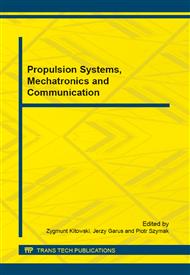p.245
p.253
p.261
p.271
p.279
p.289
p.299
p.308
p.317
Optimal Compensator for Anti-Ship Missile with Vectorization of Engine Thrust
Abstract:
This paper presents a method of controlling an anti-ship missile with the use of the linear-quadratic regulator (LQR). The equations of dynamics of the flight were linearized and written in the form of equations of state. To control the anti-ship missile, a double executive gas-dynamic (moveable nozzle of exhaust gases) and aerodynamic (moveable control surfaces) system is applied. The missile flight is considered in a three dimensional space, whereas the controlling vector is comprised of four components: two components to control the height of the flight and two components to control the direction of the flight. The results are presented in a graphic form.
Info:
Periodical:
Pages:
279-288
Citation:
Online since:
January 2016
Authors:
Keywords:
Price:
Сopyright:
© 2016 Trans Tech Publications Ltd. All Rights Reserved
Share:
Citation:


